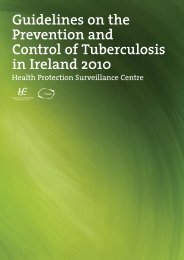Guidelines for the Early Clinical and Public Health Management of ...
Guidelines for the Early Clinical and Public Health Management of ...
Guidelines for the Early Clinical and Public Health Management of ...
You also want an ePaper? Increase the reach of your titles
YUMPU automatically turns print PDFs into web optimized ePapers that Google loves.
<strong>Guidelines</strong> <strong>for</strong> <strong>the</strong> <strong>Early</strong> <strong>Clinical</strong> <strong>and</strong> <strong>Public</strong> <strong>Health</strong> <strong>Management</strong> <strong>of</strong> Bacterial Meningitis (including Meningococcal Disease)<br />
Chapter 12.<br />
<strong>Public</strong> <strong>Health</strong> <strong>Management</strong> <strong>of</strong> Clusters <strong>of</strong> Serious<br />
Pneumococcal Disease<br />
Key points<br />
• Invasive pneumococcal disease (IPD) is a notifiable disease. Enhanced surveillance <strong>of</strong> IPD paediatric<br />
cases is routinely undertaken.<br />
• Individual cases IPD occurring in closed setting do not require public health control measures.<br />
Chemoprophylaxis is not recommended <strong>for</strong> close contacts <strong>of</strong> individual cases <strong>of</strong> IPD.<br />
• Rarely S. pneumoniae can cause clusters <strong>of</strong> serious disease. Clusters have been described in settings<br />
such as hospitals, long term care facilities, prisons, military settings, hostels, child day care centres.<br />
• Clusters <strong>of</strong> invasive pneumococcal disease (two or more cases in a closed setting in 14 days) should<br />
be reported to <strong>the</strong> local department <strong>of</strong> public health immediately <strong>for</strong> fur<strong>the</strong>r investigation.<br />
• Control measures that may be required include: infection control measures, antibiotic<br />
chemoprophylaxis, vaccination <strong>of</strong> close contacts.<br />
12.1 Introduction<br />
There is a limited evidence base <strong>for</strong> <strong>the</strong> management <strong>of</strong> clusters <strong>of</strong> severe pneumococcal disease. The following<br />
guidance data relating to clusters <strong>of</strong> severe pneumococcal disease has been based on <strong>the</strong> HPA document “Interim<br />
UK guidelines <strong>for</strong> <strong>the</strong> public health management <strong>of</strong> clusters <strong>of</strong> serious pneumococcal disease in closed settings”<br />
(July 2008). 4<br />
12.2 Definitions<br />
A suspect cluster is defined as <strong>the</strong> occurrence <strong>of</strong> two or more cases <strong>of</strong> serious pneumococcal infection occurring in a<br />
closed setting within a 14 day period (based on clinical, microbiological, epidemiological findings).<br />
A confirmed cluster is defined as two or more confirmed cases (meeting case definition) <strong>of</strong> <strong>the</strong> same (or not yet<br />
determined) serotype in a closed setting with onsets within a two week period.<br />
A closed setting is defined as a setting where <strong>the</strong> individuals are normally in close contact with each o<strong>the</strong>r <strong>and</strong><br />
include <strong>the</strong> following settings: household, residential home, hospital ward, military establishment, prison, homeless<br />
shelter, children’s day care centre <strong>and</strong> o<strong>the</strong>r similar settings.<br />
Close contact is defined as an individual who has had significant contact with a cluster case in <strong>the</strong> closed setting.<br />
The period <strong>of</strong> significant contact is from 48 hours be<strong>for</strong>e onset <strong>of</strong> symptoms in <strong>the</strong> case until completion <strong>of</strong> 24 hours<br />
<strong>of</strong> systemic antibiotic treatment.<br />
Significant contact may be ei<strong>the</strong>r prolonged or transient. Prolonged contact is defined as ei<strong>the</strong>r overnight or<br />
daytime stay in <strong>the</strong> same closed setting.<br />
Transient close contact is defined as when <strong>the</strong> mouth or nose is directly in contact with <strong>the</strong> large droplets or<br />
secretions from <strong>the</strong> respiratory tract <strong>of</strong> a cluster case during <strong>the</strong> acute illness.<br />
-81-

















